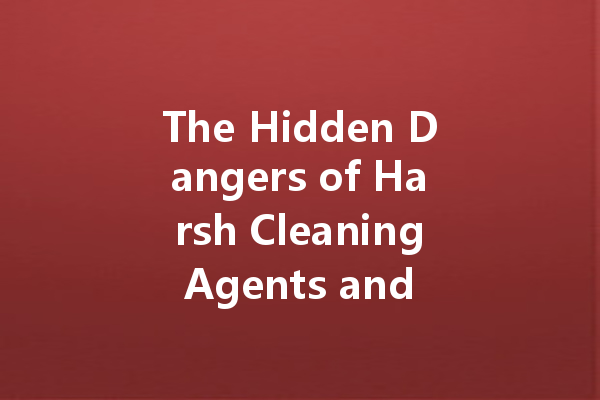Introduction
Cleaning agents play a crucial role in maintaining cleanliness and hygiene in our homes and workplaces. However, many conventional cleaning products contain harsh chemicals that can pose significant risks to our health and the environment. In this article, we will explore the dangers associated with these harsh cleaning agents and provide practical tips on how to avoid them.
Understanding Harsh Cleaning Agents
Harsh cleaning agents typically contain a variety of synthetic chemicals designed to break down dirt and grime effectively. Common ingredients in these products include ammonia, bleach, phthalates, and various solvents. While these chemicals can be effective at cleaning, they can also have detrimental effects on human health and the environment.
Health Risks Associated with Harsh Cleaning Agents
Many cleaning products release volatile organic compounds (VOCs) that can irritate the respiratory system. Prolonged exposure to these chemicals may lead to chronic respiratory issues, including asthma and allergies. Individuals with preexisting conditions, such as asthma or bronchitis, are particularly vulnerable.
Direct contact with harsh cleaning agents can cause skin irritation, rashes, and allergic reactions. Ingredients like bleach and other strong detergents can strip the skin of its natural oils, leading to dryness and irritation, especially for those with sensitive skin.
In some cases, concentrated cleaning agents can cause chemical burns if they come into direct contact with the skin. It’s essential to read labels carefully and follow safety precautions to minimize these risks.
Some studies suggest that prolonged exposure to certain cleaning chemicals may be linked to serious health risks, including hormone disruption, reproductive issues, and even certain types of cancer. Understanding these long-term effects can help consumers make informed choices.
Environmental Impact of Harsh Cleaning Products
Beyond human health, harsh cleaning agents can have a significant negative impact on the environment.
Water Pollution
Many cleaning agents end up in our waterways through the drain after household cleaning. Chemicals like phosphates and nitrogen can contribute to water pollution, leading to algae blooms that deplete oxygen levels in water bodies and harm aquatic life.

Air Quality Degradation
The VOCs released into the air from cleaning products can contribute to indoor air pollution. This, in turn, can exacerbate climate change and affect air quality for both humans and wildlife.
Harm to Wildlife
Chemical runoff from cleaning products can be harmful to wildlife. Contaminated water sources can affect the health of fish and other animals, leading to declines in populations and biodiversity.
Choosing Safer Alternatives
Fortunately, there are several ways to clean effectively without resorting to harsh chemicals.
Opt for Natural Cleaning Products
Many companies now offer eco-friendly cleaning products made from plant-based ingredients that are less harmful to both human health and the environment. Look for certifications like Green Seal or EcoLogo that indicate compliance with environmental standards.
DIY Cleaning Solutions
Creating homemade cleaning solutions is an excellent way to avoid harsh chemicals. Common ingredients such as vinegar, baking soda, and lemon juice can effectively clean surfaces without the risks associated with commercial products.
Read Labels Carefully
When purchasing cleaning products, always read the labels. Look for non-toxic, biodegradable, and phosphate-free labels. Avoid products that list hazardous ingredients and opt for those with clear and simple ingredient lists.
Use Disinfecting Alternatives
For disinfecting purposes, consider using essential oils like tea tree oil or eucalyptus, which have natural antibacterial properties. These alternatives are effective and significantly less toxic than conventional disinfectants.
Conclusion
While cleaning is essential for maintaining hygiene, it’s crucial to be mindful of the products we use. Harsh cleaning agents pose various health and environmental risks that can affect both our well-being and the planet. By understanding these dangers and adopting safer alternatives, we can create a cleaner, healthier environment. Choose wisely, clean responsibly, and make a positive impact on your health and the Earth.
